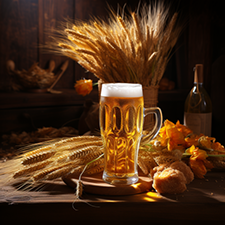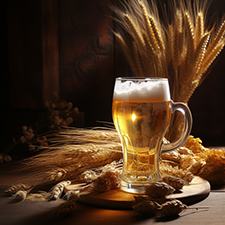Wheat Beers Decoded: The What, Why, and How of Brewing with Wheat
Posted by Matteo Lahm on 18th Feb 2024
You've mastered the art of barley, but have you ever taken a walk on the wheat side? If not, let's delve into the fascinating world of wheat beers and uncover what makes them so refreshingly unique.
Wheat, the fun-loving cousin in the grain family, brings a whole new dynamic to the beer-making process. It's like inviting a jazz musician to a classical concert; the result is a symphony of flavors that's both familiar and excitingly different.
The magic of wheat lies in its chemical composition. It's packed with proteins, more so than its straight-laced sibling, barley. These proteins are the secret agents behind the unique characteristics of wheat beers. They're responsible for that creamy, full-bodied texture that slides down your throat smoother than a Sinatra ballad. Not to mention, they contribute to the formation of that thick, long-lasting head that's a signature of wheat beers.

As for the flavors, wheat has a light, crisp taste that's as refreshing as a cool breeze on a hot day. This is largely due to its terpene profile. Terpenes, the aromatic compounds that give plants their unique scents and flavors, in wheat contribute subtle citrus and floral notes. This is why wheat beers and a slice of orange go together like peanut butter and jelly.
But what about the ABV and why is it lower in wheat beer? The answer lies in the sugar content. Barley is the sugar daddy of grains, with more enzymes to convert starches into fermentable sugars. Wheat, on the other hand, is more of a sugar momma, with fewer enzymes, resulting in less sugar and a lower ABV.
So, how do you use wheat in your brews? It's all about balance. Wheat can add complexity and depth to the flavor profile, but too much can make your beer heavier than a Black Sabbath riff. The best practice is to use wheat as a supplement to barley, not a replacement. Play around with different grain combinations until you find the perfect blend.
Just as wheat beers are distinct, there are hop varieties that pair especially well with wheat beers. Traditional German and Czech hops, like Hallertau and Saaz, are known for their mild bitterness and floral, spicy aromas. They complement the light, crisp flavors of wheat perfectly.

So now that we have clarified how and why wheat beers are distinct, let’s get technical on the brewing process. There are some things to account for during the mash and sparge. When it comes to wheat beers, these steps do have their own unique quirks.
First, let's talk about mashing. Because wheat has a higher protein content than barley, it can make the mash thicker and more prone to a stuck sparge. It's like trying to wade through a swimming pool filled with oatmeal. To avoid this, you might want to consider a protein rest during the mash. This step, done at a lower temperature (around 122°F or 50°C), helps break down the proteins and makes the mash less viscous.
Now, onto sparging. Because of the aforementioned high protein content, wheat beers can benefit from a batch sparge rather than a continuous sparge. This method involves adding all your sparge water at once, giving it a good stir, and then draining it off. It's a bit like making a giant pot of tea. This can help prevent a stuck sparge and ensure you extract all the delicious sugars from your grains.
Temperature is always a key player in the brewing process, and wheat beers are no exception. Wheat beers are often fermented at slightly higher temperatures than their barley counterparts. This is because the yeast strains used in wheat beers (like the classic German Weizen yeast) tend to produce more of their signature fruity and spicy flavors when fermented at warmer temperatures (around 68-72°F or 20-22°C).
So, there you have it! A few tweaks to your mash, sparge, and fermentation temperatures can make all the difference when brewing a wheat beer. In the spirit of marrying art and science, don your lab coat, put on your French beret, roll up your sleeves, and get brewing!

